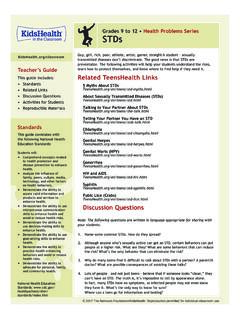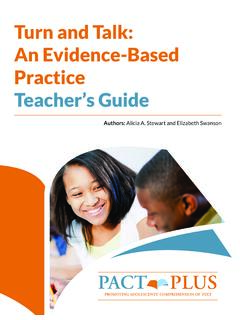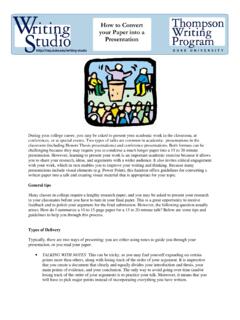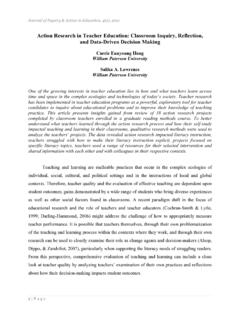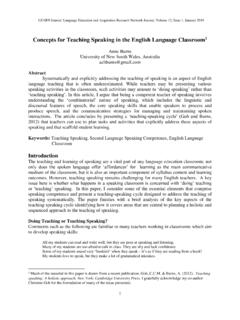Transcription of Effective Questioning and Classroom Talk
1 Ged Gast Creativity Consultant 1 Effective Questioning and Classroom Talk To develop learning & higher order thinking, promoting imagination, speculation, creative thinking & to pitch a suitable challenge level Asking questions is natural and intuitive. Teachers ask questions from the start of the lesson until the end. Asking questions forms part of any lesson because it invites the student to think, and even within a lecture style lesson, rhetorical questions are used to invite silent agreement or begin the organisation of ideas to present a response. Research suggests teachers ask over 400 questions a day. Teachers use questions to engage the students and sustain an active style to the learning. The teacher also uses questions as part of the assessment of learning in order to determine how they best structure, organise and present new learning.
2 However, research has found that many teachers wait only for seconds before seeking an answer. Developing Questioning approaches, requires much greater emphasis on the time provided for students to think individually, collaboratively and deeply to enable them to develop answers and to share better answers. This will improve their thinking and engagement. Historically, teachers have asked questions to check what has been learnt and understood, to help them gauge whether to further review previous learning, increase or decrease the challenge, and assess whether students are ready to move forward and learn new information (factual checks ie Closed questions). This can be structured as a simple teacher versus the class approach (Bat and Ball), where the teacher asks a question and accepts an answer from a volunteer, or selects/conscripts a specific student to answer.
3 These approaches are implicit in any pedagogy, but teachers need a range of Open Questioning strategies to address different learning needs and situations. Teachers must also pitch questions effectively to raise the thinking challenge, target specific students or groups within the class. This guidance informs teachers how to pre-plan their questions and select approaches for promoting Classroom talk; prepare their open and high-challenge questions; pre-determine the level and type of challenge they wish to set, who they will target and how they will target specific groups in the Classroom . How and why do we use Questions and Talk in the Classroom ? Teachers use Questioning as part of their teaching for many reasons, but often to: maintain the flow of the learning within the lesson; engage students with the learning; assess what has been learned, and check that what has been learnt is understood and applied; test student memory and comprehension; to initiate individual and collaborative thinking in response to new information; seek the views and opinions of pupils; provide an opportunity for pupils to share their opinions/views, seeking responses from their peers; encourage creative thought and imaginative or innovative thinking; foster speculation, hypothesis and idea/opinion forming; create a sense of shared learning and avoid the feel of a lecture ; challenge the level of thinking and possibly mark a change to a higher order of thinking.
4 Model higher order thinking using examples and building on the responses of students. All the following examples and many others are useful and necessary within different Classroom situations. They help teachers move students from simple responses, to engage in more developed complex thinking. This helps them apply what they understand, to bridge learning from other times and different situations, to think more actively in lessons and learn from the answers given by other students. Ged Gast Creativity Consultant 2 Questioning approaches thinking time , the no hands rule and phone a friend Strategy/approach Process Gains and benefits Thinking Time: Consciously waiting for a pupil or class to think through an answer (before you break the silence) 15-30secs Provide time between setting the question and requiring an answer.
5 Sometimes alerting pupils to the approach and the time available to develop an answer. Prompts depth of thought and increases levels of challenge. Ensures all pupils have a view or opinion to share before an answer is sought. Time Out: Time for thinking and talking Time provided for thinking and talking partners, before seeking answers. Pupils have thinking time, actively think and collaborate to form answers. No Hands Questioning : Using the no hands up rule Ref. AfL publication - Working Inside the Black Box. Pupils aware that those required to give an answer, will be selected by the teacher. Teachers alert them to this as questions are asked. Linked to thinking time . Improves engagement and challenges all pupils to think. When linked to Thinking Time, pupils share ideas and position their own views in relation to others. Basketball Questioning : Move questions and discussions between pupils Teacher establishes movement of ideas and responses around the class.
6 Builds on other pupils ideas and comments. Accepts half-formed ideas. NB not ping-pong Engages more pupils. Stops teacher being focus for all Questioning . Develops connected thinking and development of ideas. Conscripts and Volunteers: Using a planned mix of conscripts and volunteers Teacher selects answers from those who volunteer an answer and an equal amount of those who do not. Enhances engagement and challenge for all. Phone a friend: Removes stress to enable those who cannot answer to participate Those who cannot answer are allowed to nominate a fellow pupil to suggest an answer on their behalf, but they still have to provide their own answer, perhaps building on this. Encourages whole-class listening and participation. Removes stress and builds self-esteem. Hot-seating: A pupil is placed in the hot-seat to take several questions from the class and teacher. Encourages listening for detail and provides challenge Mantle of the expert: A wears the cloak of the expert to answer questions from the class.
7 Builds self-esteem through opportunity to share detailed knowledge. Preview: Previewing questions in advance Questions are shared/displayed before being asked, or the start of the lesson. Signals the big concepts and learning of the lesson Pair rehearsal: of an answer or a question Pairs of pupils are able to discuss and agree responses to questions together. Encourages interaction, engagement and depth Eavesdropping: Deploying specific targeted questions Listen in to group discussions and target specific questions to groups and individuals. Facilitates informed differentiation. 5Ws: Modeling simple exploratory questions to gather information Teacher models the use of Who, What, Where, When and Why to set out a simple information gathering response based on the information provided. Encourages students to rehearse enquiry and comprehension, can extend into reasoning and hypothesis. Creates an inquisitive disposition and a thinking or self reflective approach to learning.
8 Eavesdropping: Deploying specific targeted questions Listen in to group discussions and use this to target specific questions to particular groups and individuals. Facilitates informed differentiation as teachers use what they overhear to modify planning and further Questioning . Ged Gast Creativity Consultant 3 Many of these Questioning strategies and approaches are taken from the National Secondary Strategy for School Improvement, The Questioning guidance from the Pedagogy and Practice Pack materials and the Assessment for Learning Handbook, or from the work of members of the AfL team including Paul Black and Christine Harrison at King s College, London. Strategy/approach Process Gains and benefits High Challenge: Phrasing questions carefully to concentrate on Bloom s Taxonomy higher challenge areas Questions must be pre-planned, as very difficult to invent during a lesson.
9 Focus questions to address analysis, synthesis, evaluation and creativity, based on Bloom s Taxonomy. Provides high challenge thinking, requiring more careful thought, perhaps collaborative thinking and certainly longer more detailed answers. For Able, Gifted and Talented. Staging or sequencing: questions with increasing levels of challenge Increasing the level of challenge with each question, moving from low to higher-order Questioning Helps pupils to recognise the range of possible responses and to select appropriately. Big questions: The setting of a substantial and thought provoking question Big questions cannot be easily answered by students when the question is posed. They are often set at the beginning of the lesson and can only be answered by the end of the lesson, using all of the thinking based on all of the contributions to the lesson. These questions develop deeper and more profound thinking.
10 Big Questions are often moral issues or speculative questions such as, Where are we from? How big is the universe? What is the meaning of life? They require extended answers and usually rely on collaborative thinking and a personal interpretation of the information provided. Focus Questioning : This will help students to answer bigger questions When students struggle to answer bigger or more complex Questioning , the teacher can model or lead the thinking by asking Focus questions to lead the student through the steps of the thinking. Develops confidence and the sequencing of small steps in thinking and response. Allows students to reveal the stages in their thinking. Fat questions: Seeking a minimum answer Pupils are not allowed to answer a question using less than 15 words or using a particular word or phrase. They must give an extended answer or make a complete sentence/phrase. Develops speaking and reasoning skills, the correct use of critical and technical language.


